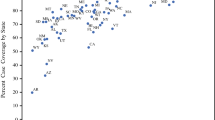Abstract
Background
The National Cancer Data Base (NCDB) is a large, geographically diverse hospital-based cancer registry that has been used to study factors related to cancer diagnosis, treatment, and survival. The primary purpose of this study was to compare the case counts and characteristics of patients in NCDB with population-based registries reported in the United States Cancer Statistics (USCS).
Methods
Cancer case counts from NCDB were compared to case counts from USCS to measure NCDB’s case coverage, or the percentage of cases captured. Case coverage was examined by a variety of characteristics, including state of residence, race/ethnicity, age, and primary cancer site.
Results
The overall NCDB case coverage was 67.4 %, ranging from a high of 88.7 % for Delaware to a low of 27.1 % for Arizona. Case coverage for white, black, and Asian/Pacific Islander cases was high (64.7 % to 67.4 %), but it was much lower for American Indians/Alaskan Natives (32.8 %) and those of Hispanic ethnicity (51.1 %). Among the elderly (aged 65 + years), case coverage is much lower compared to persons younger than 65 (63.0 % and 73.0 %, respectively). Case coverage also varied widely by site, with the highest being cervix (77.9 %) and the lowest being melanoma (50.6 %).
Conclusions
This study highlights the geographic- and site-specific variation in NCDB case coverage, primarily as a result of NCDB facility presence and data collection and processing protocols. These findings illustrate the strengths and limitations of NCDB as a resource for nationwide data on cancer diagnosis, treatment, and survival.

Similar content being viewed by others
References
American College of Surgeons Cancer Programs. National Cancer Data Base. 2011. http://www.facs.org/cancer/ncdb/index.html. Accessed March 13, 2012.
Bilimoria KY, Stewart AK, Winchester DP, Ko CY. The National Cancer Data Base: a powerful initiative to improve cancer care in the United States. Ann Surg Oncol. 2008;15:683–90.
American College of Surgeons Cancer Programs. About accreditation. 2009. http://www.facs.org/cancer/coc/whatis.html. Accessed August 2, 2012.
Jemal A, Murray T, Ward E, Samuels A, Tiwari RC, Ghafoor A, et al. Cancer statistics, 2005. CA Cancer J Clin. 2005;55:10–30.
Pickle LW, Hao Y, Jemal A, Zou Z, Tiwari RC, Ward E, et al. A new method of estimating United States and state-level cancer incidence counts for the current calendar year. CA Cancer J Clin. 2007;57:30–42.
Bilimoria KY, Bentrem DJ, Stewart AK, Winchester DP, Ko CY. Comparison of commission on cancer-approved and -nonapproved hospitals in the United States: implications for studies that use the National Cancer Data Base. J Clin Oncol. 2009;27:4177–81.
United States Cancer Statistics (USCS) Technical Notes: Contributors. 2010. http://www.cdc.gov/cancer/npcr/uscs/2007/technical_notes/contributors/. Accessed March 13, 2010.
United States Cancer Statistics (USCS) Technical Notes: USCS publication criteria. 2010. http://www.cdc.gov/cancer/npcr/uscs/2007/technical_notes/criteria.htm. Accessed March 13, 2012.
Puts MT, Monette J, Girre V, Wolfson C, Monette M, Batist G, et al. Characteristics of older newly diagnosed cancer patients refusing cancer treatments. Support Care Cancer. 2010;18:969–74.
Turner NJ, Haward RA, Mulley GP, Selby PJ. Cancer in old age—is it inadequately investigated and treated? BMJ. 1999;319(7205):309–12.
American College of Surgeons Cancer Programs. Data submission information. 2011. http://www.facs.org/cancer/ncdb/datasubmission.html. Accessed April 19, 2012.
Area Resource File (ARF). National County-level Health Resource Information Database. http://arf.hrsa.gov/overview.htm. Accessed April, 2012.
United States Cancer Statistics (USCS) Technical Notes: Data sources: incidence data. 2010. http://www.cdc.gov/cancer/npcr/uscs/2007/technical_notes/data_sources/incidence.htm. Accessed March 13, 2012.
US Cancer Statistics Working Group. United States cancer statistics, 1999–2007 incidence and mortality Web-based report. Atlanta: US Department of Health and Human Services, Centers for Disease Control and Prevention and National Cancer Institute, 2010. http://www.cdc.gov/uscs. Accessed March 13, 2012.
United States Cancer Statistics (USCS). Interpreting the data: race and ethnicity in cancer data. 2010. http://www.cdc.gov/cancer/npcr/uscs/2007/technical_notes/interpreting/race.htm. Accessed March 20, 2012.
NAACCR Race and Ethnicity Work Group. Springfield, IL: North American Association of Central Cancer Registries, September 2011.
Howe HL. Evaluation of NHIA submissions for 1997–2001. Springfield, IL: North American Association of Central Cancer Registries, 2005.
Hispanics in the United States: ethnicity and ancestry branch, population division. US Census Bureau, 2006.
Espey DK, Wiggins CL, Jim MA, Miller BA, Johnson CJ, Becker TM. Methods for improving cancer surveillance data in American Indian and Alaska Native populations. Cancer. 2008;113(5 Suppl):1120–30.
Havener L, Hu KU, West DW. Standards for cancer registries, vol. 2: data standards and data dictionary. 10th ed, version 11. Springfield, IL: North American Association of Central Cancer Registries, 2004.
Ogunwole SU. The American Indian and Alaska Native population, 2000. US Department of Commerce, Economics and Statistics Administration, US Census Bureau, 2002.
Howlader N, Noone AM, Krapcho M, Neyman N, Aminou R, Waldron W, et al. SEER cancer statistics review, 1975–2009 (vintage 2009 populations). 2012. http://seer.cancer.gov/csr/1975_2009_pops09/. Accessed based on November 2011 SEER data submission.
US Census Bureau. Statistical abstract of the United States, 2012. 131st ed. 2011. http://www.census.gov/compendia/statab/. Accessed April, 2012.
Bailey L. Aging Americans: stranded without options. Washington, DC: Surface Transportation Policy Project, 2004.
American College of Surgeons Cancer Programs. Cancer program accreditation. 2011. http://www.facs.org/cancer/coc/approved.html. Accessed April 25, 2012.
American College of Surgeons Cancer Programs. Participant user files. 2011. http://www.facs.org/cancer/ncdb/participantuserfiles.html. Accessed March 22, 2012.
Acknowledgment
We thank Elizabeth Ward, Stacey Fedewa, and Katherine Virgo from the ACS’s Intramural Research Department for their help and guidance with this project. Supported in part by ACS Intramural Research funds.
Disclosure
The authors declare no conflict of interest.
Author information
Authors and Affiliations
Corresponding author
Rights and permissions
About this article
Cite this article
Lerro, C.C., Robbins, A.S., Phillips, J.L. et al. Comparison of Cases Captured in the National Cancer Data Base with Those in Population-based Central Cancer Registries. Ann Surg Oncol 20, 1759–1765 (2013). https://doi.org/10.1245/s10434-013-2901-1
Received:
Published:
Issue Date:
DOI: https://doi.org/10.1245/s10434-013-2901-1




